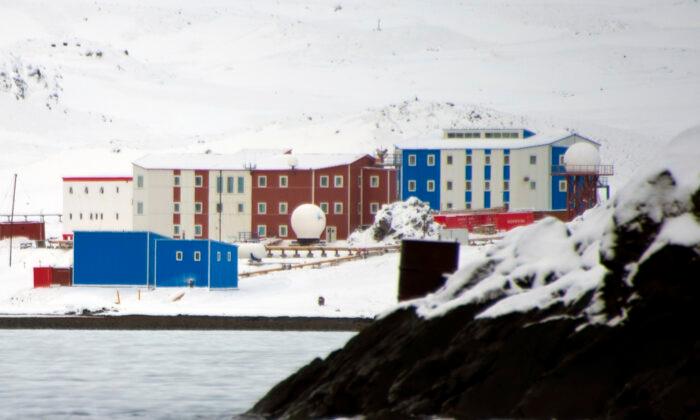In the first week of November, the United States was faced with a clear warning, the likes of which it hasn’t faced since the Cold War: the prospect of having to fight near simultaneous major wars in Europe and Asia.
In March and April, Russia mobilized about 100,000 to 120,000 troops, plus supporting armor, artillery, and missiles, near the Donbass regions contested by Russian-supported Ukrainian rebel forces and in the Ukrainian territory of Crimea.
This was more than what Russia mobilized in 2014 to invade and occupy Crimea. The United States European Command raised its “watch level” to “potential imminent crisis.”
Now in November, Russia has again remobilized its troops and the Biden administration is sounding the alarm. On Nov. 10, speaking at the State Department with Ukrainian Foreign Minister Dmytro Kuleba, Secretary of State Antony Blinken warned that Russia may be “attempting to rehash” its 2014 invasion of Crimea.
Also, in the first week of November, a number of images and videos appeared on the Chinese internet showing the movement of large numbers of ZBD-05 amphibious infantry fighting vehicles, artillery, and trucks—all from an unidentified People’s Liberation Army Ground Force unit moving to the city of Hangzhou.
Hangzhou is near the mouth of the Qiantang River and is just south of Shanghai, through which flows the Yangtze River. Both rivers likely employ thousands of large roll-on-roll-off (RORO) barges the size of 10 tank-carrying Landing Ship Tanks (LSTs), which is also used by the People’s Liberation Army Navy (PLAN).
So as Russia was demonstrating its ability to invade Ukraine, China was demonstrating its potential to mobilize Army amphibious invasion units and the thousands of RORO barges that will transfer the vast bulk of the PLA’s attempt to conduct an amphibious and airborne invasion of Taiwan—larger than D-Day in 1944.
China and Russia have probably spent the last decade talking about how to execute simultaneous attacks that tie down U.S. forces in Europe and Asia, preventing U.S. reinforcements between the two theaters, thereby increasing the chances of Chinese and Russian victories.
Over the last decade, China and Russia have held multiple Ground Force and Joint Force exercises annually, along with numerous multilateral exercises and near annual naval exercises. Their increasing cooperation in nuclear “missile defense” strongly indicates they are also preparing for joint nuclear “missile offense.”
Today the United States simply is not prepared to fight two simultaneous major wars, both against nuclear superpowers. During the Cold War, the U.S. planned on fighting two wars, and sometimes two and a half wars.
But during the Cold War, the United States and its allies successfully avoided a third world war, deterred the Soviet Union from invading Europe, deterred China from invading Taiwan, and deterred North Korea from invading South Korea.

In all three theaters, the United States built alliances that did a very good job of establishing the conventional forces necessary to deter. But what made the U.S. and allied effort credible and successful was a full-spectrum commitment to nuclear deterrence—from intermediate-range ballistic and cruise missiles, to short-range ballistic missiles, tactical nuclear bombs, and tactical nuclear artillery shells.
Perhaps the most decisive of these were U.S. tactical nuclear artillery shells. These were deployed to Europe in the mid-1950s to counter the Soviet and Warsaw Pact superiority in conventional invasion forces; to Taiwan in 1958 to deter Mao Zedong from invading the island; and to South Korea in 1958, to deter much larger North Korean invasion forces.
The 5 to 10 kiloton blast capable, 203 mm diameter, W33, fired from the large M110 cannon, could take the place of 166 to 333 strikes by the B-52 bomber. The much smaller 155 mm W48 was capable of only a .072 kiloton blast, or about two B-52 strikes.
Tactical nuclear artillery shells were withdrawn from Taiwan in 1971, and from Europe and South Korea in 1991; by 1996 the United States had destroyed its tactical nuclear artillery shells.
Today, for tactical nuclear deterrent, the United States has about 500 B-61 tactical nuclear bombs, of which about 200 reportedly are deployed to Europe. But these can only be delivered by large bombers like the B-52, or an array of fourth and fifth generation fighters, all of which are increasingly vulnerable to sophisticated Russian and Chinese anti-stealth capable air defense missiles.
In contrast, a 155 mm artillery shell travels over 2,000 miles per hour and is very small, making it much less vulnerable to missile-based defenses, though laser-based defenses are advancing rapidly.
In 2020, the Trump administration started filling a need for a survivable U.S. long-range tactical nuclear deterrent by deploying the 5 kiloton capable W76-2 warhead on some Trident nuclear ballistic missile submarines, but use of these large strategic missiles risks escalation into a major nuclear war.
However, as the United States and its allies concluded in the mid-1950s, so, too, today: an economical and decisive option for deterring attack by numerically superior Russian, Chinese, and North Korean invasion forces would be for the United States to reintroduce tactical nuclear artillery shells to its Army and Marine artillery forces.
Such weapons do not threaten Beijing, Moscow, or even Pyongyang. They only threaten Russian army forces that would destroy an independent Ukraine, the Chinese invasion forces that would destroy freedom on Taiwan, and North Korean invasion forces that would end South Korea’s democracy.
Furthermore, the only defense that Russian, Chinese, and North Korean invasion forces would have from U.S. tactical nuclear artillery would be to hit them first. But if their attempt to do so failed, so, too, would their invasion campaign, which could then prove fatal to their brittle dictatorships.
While reviving a tactical nuclear artillery capability may be counter to the Biden administration’s putative nuclear arms control agenda, it is on the agenda of Americans, especially draft-age Americans, who may not want to march off to wars that we can deter in the first place.





